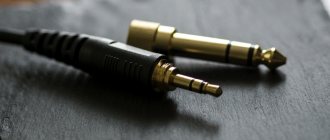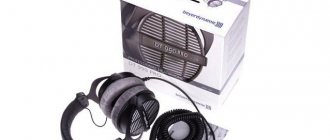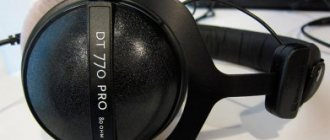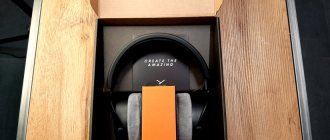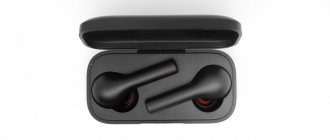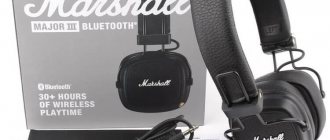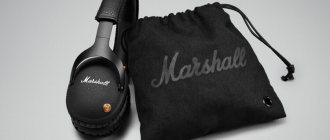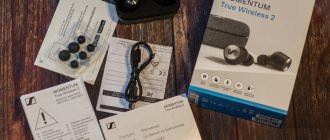Last year, the German Beyerdynamic celebrated its 88th anniversary and released a limited-edition low-impedance version of its DT 770 PRO . The history of this model goes back more than 20 years. Previously, the Germans produced 250-ohm and 80-ohm versions, but due to the success of the limited 32-ohm modification, the company decided to launch its mass production in 2013. For many years, Beyerdynamic DT 770 PRO 250 Ohm headphones have been used in many studios and on television, for example, in the film “Radio Day” many artists play in this particular model.
What is the key to the success of these headphones and what are the differences between the new 32-ohm version? Let’s take a closer look at them.
Appearance and design of Beyerdynamic DT 770 PRO
Both models are almost identical in appearance to each other. High-quality materials assembled by hand are the hallmark of all Beyerdynamic headphones. The durable metal headband is encased in a soft faux leather cushion. To move the clamps apart, it is necessary to apply sufficient force, which, on the one hand, reduces practicality, and on the other hand, prevents accidental displacement. The design of the over-ear headphones is not foldable, the weight of the headphones (270 grams without cable) is noticeable, but they are suitable for long-term use. The wire is thick and elastic. The ear pads are quite large and will appeal to many people.
Differences between Beyerdynamic DT 770 PRO 32 Ohm and Beyerdynamic DT 770 PRO 250 Ohm:
- The limited edition features updated 32-ohm speakers;
- The limited version has leather ear pads, the 250-ohm version has velor;
- The wire in the limited version is straight (1.6 m), while in the 250-ohm version it is mostly twisted and longer (3 m);
- The headboard cushion is made of glossy faux leather; the 250-ohm ones have a matte surface;
- Minor changes in the design - on the side nameplates of the limited version the name has been changed to DT 770 PRO Limited Edition 32 Ohm, and the small inscription 88 is also applied throughout the nameplate.
In general, we can say that we have two models of the highest build quality, mainly for home use.
Design and ergonomics
The appearance of the DT 770 PRO is familiar and well recognizable to many. The design of the DT 770 PRO is distinguished by its massiveness, round bowls made of thick plastic, velor ear pads and a non-removable cable. Both versions, 80 and 250 Ohm, are the same in materials and appearance, but differ in cable.
A few words about the cable. The cable connects to one (left) earcup of the headphones, which, according to Beyerdynamic, prevents it from getting tangled during operation. Previously, in the 80 and 250 Ohm versions, the cable was twisted, about 1.5 m long with the ability to stretch up to 3 m. Now, for 80 Ohm headphones it has become straight (3 m), while for 250 Ohm it remains twisted and stretchable up to 3 m. The advantages and disadvantages of each cable modification will depend, rather, on the specific usage scenario and on the person’s personal preferences. For example, the option with a direct cable suited me better, as it turned out to be more convenient for home use when listening with portable or small stationary devices. As I already noted in one of my previous reviews of Beyerdynamic headphones, the weight of the coiled cable on the earcup is felt more strongly, and when stretched, such a cable can pull small sound sources with it. But since the DT 770 PRO 250 Ohm are presented as headphones for use with massive professional studio equipment, this shouldn't be a problem. In my case, for portable sources, a straight cable turned out to be less problematic, but a twisted cable looks more solid.
The headphones look very impressive in size, but the right combination of different materials and thoughtful ergonomics make the DT 770 PRO very comfortable. The ergonomics of the headphones themselves have never raised any questions for me. An adjustable headband with soft eco-leather, velor ear pads, and large round cups that completely cover the ears allow you to wear the headphones for a long time without any unpleasant sensations.
Beyerdynamic DT 770 PRO equipment
The equipment of both models is not very diverse - in addition to the headphones, the large cardboard box contains a screw-on gold-plated 6.3 m adapter, instructions and a brochure with warranty conditions.
The packaging of the limited edition is gift-like and looks impressive.
Packaging and equipment
Each Beyerdynamic DT 770 PRO model, regardless of version, comes in a box that differs only in the resistance numbers in the small orange circle on the top edge. In the current revision of the DT 770 PRO, the box is completely black with a photo of the headphones and large white letters indicating the model number and making up the slogan - Your legend, Your Sound; written in smaller letters – Your Beyerdynamic. The box is large, made of thick cardboard. Inside, the headphones are placed on an original beveled cardboard stand.
For headphones intended for professional use, the kit includes everything you need for work. The DT 770 PRO kit includes a good case for headphones made of synthetic fabric with a tag indicating the contacts of the owner of the headphones and a gold-plated adapter from 3.5 to 6.3 mm.
Ergonomics of Beyerdynamic DT 770 PRO headphones
The fit of both headphones is comfortable; some may not find it the peak of comfort, like the Sennheiser HD 700, for example, but when listening to music in them for more than an hour, no discomfort is experienced. The pressure on the head is moderate; together with the artificial leather ear pads, good noise insulation is provided. The ear pads are quite large and will appeal to many people. The height of the bow is adjustable discretely.
Sound of Beyerdynamic DT 770 PRO
For testing, we used the NuForce Icon HDP DAC, two Hi-End players - Colorfly C4 Pro and Astell & Kern AK100, as well as several standard models - Colorfly C3, Hisoundaudio RoCoo BA and Sony NWZ-F806.
The sound of both versions of the headphones when listening to music in FLAC format left a pleasant impression. The low frequencies are more pronounced in the limited edition, which will appeal to many fans of electronic music. I recommended the classic 250-ohm version to fans of more diverse compositions (jazz, blues, rock).
Technical measurements of Beyerdynamic DT 770 PRO 32 Ohm LE
| General overview of the technical parameters of Beyerdynamic DT 770 Pro 32 ohm LE headphones | |||
| channel | general* | left | right |
| Sensitivity average in the range 100 Hz 10 kHz, dB/V | 110,3 | 111,1 | 108,0 |
| Average resistance in the range 40 Hz 15 kHz, Ohm | 34,0 | 34,0 | 34,3 |
| For 94.0 dB SPL required, V | 0,152 | 0,139 | 0,198 |
| For 94.0 dB SPL required, mW | 0,685 | 0,572 | 1,149 |
| Detailed description of the values in the table | |||
| You can calculate the SPL level of headphones with a specific amplifier using an online calculator | |||
*the overall headphone channel is obtained by averaging the frequency response between the right and left channels. The sensitivity of the Beyerdynamic DT 770 PRO 32 Ohm LE is at a sufficient level for the class of full-size headphones at 110.3 dB/V.
According to the passport data, the sensitivity is 96 dB/mW at 1 kHz at 1 mW. Beyerdynamic measures according to IEC standards, according to which the measurement occurs at a feed rate of 500 Hz, but the website erroneously states a feed rate of 1 kHz. Our measurements showed, at a supply of 500 Hz, 97.6 dB/mW at 500 Hz at 1 mW, which is higher than the passport values obtained under other conditions. The measured resistance value of 34 Ohms differs little from the declared 32 Ohms, which indicates low impedance among full-size Beyerdynamic DT 770 PRO 32 Ohm LE headphones. This value is sufficient for use with most standard players, such as Sony NWZ-F806. On the chart, the resistance does not have significant peaks or troughs.
If the player is low-power, then you will need a portable amplifier that provides the required sound volume.
If the amplifier has a constant output internal impedance of 20 ohms (the most common), then the midrange frequencies around 350 Hz will increase by 0.7 dB. When interacting with standard players such as the Colorfly C3, low frequencies will be reduced by 1.6 dB. RAA Report:
Full technical report on Beyerdynamic DT 770 PRO 32 Ohm LE
Features of use
Beyerdynamic DT 770 PRO headphones are available in three versions with different impedances: 32, 80, 250 Ohms. The difference in configuration is insignificant, but in the type of use it is of a certain importance. The higher the impedance, the more demanding the device is on the transmitting device.
If headphones with an impedance of 32 Ohms can be safely used with mobile devices, enjoying fairly high-quality melodies, then models with an impedance of 250 Ohms must be connected specifically to professional equipment.
5 Best Beyerdynamic Headphones
Technical measurements of Beyerdynamic DT 770 PRO 250 Ohm
| General overview of the technical parameters of Beyerdynamic DT 770 PRO 250 ohm headphones | |||
| channel | general* | left | right |
| Sensitivity average in the range 100 Hz 10 kHz, dB/V | 98,0 | 99,0 | 96,8 |
| Average resistance in the range 40 Hz 15 kHz, Ohm | 260,3 | 260,3 | 260,5 |
| For 94.0 dB SPL required, V | 0,629 | 0,564 | 0,725 |
| For 94.0 dB SPL required, mW | 1,519 | 1,223 | 2,017 |
| Detailed description of the values in the table | |||
| You can calculate the SPL level of headphones with a specific amplifier using an online calculator | |||
*the overall headphone channel is obtained by averaging the frequency response between the right and left channels. The sensitivity of the Beyerdynamic DT 770 PRO 250 Ohm is at a slightly lower level for the class of full-size headphones at 98 dB/V, so high-quality amplification will be required. According to the passport data, the sensitivity is 96 dB/mW at 1 kHz at 1 mW. Let us remind you that Beyerdynamic carries out measurements according to IEC standards, according to which measurements occur at a feed rate of 500 Hz (however, the website erroneously indicates a feed rate of 1 kHz). Our measurements showed, at a supply of 500 Hz, 91.8 dB/mW at 500 Hz at 1 mW, which is lower than the passport values obtained under other conditions. The measured resistance of 260.3 Ohms is slightly different from the declared 250 Ohms, which indicates the high impedance of the Beyerdynamic DT 770 PRO 250 Ohm full-size headphones. This value means that the headphones can only be used with certain models of portable amplifiers or with stationary amplifiers, such as the Laconic Night Blues Mini or Meier Audio Corda Symphony.2. On the chart, the resistance does not have significant peaks or troughs. If the amplifier has a constant output impedance of 20 ohms (the most common), then the upper midrange frequencies around 1200 Hz will increase by 0.1 dB. When interacting with standard players such as Colorfly C3, low frequencies will decrease by 0.2 dB. RAA Report:
Full technical report on Beyerdynamic DT 770 PRO 250 Ohm
Sound
The sound of the DT 770 PRO is described in detail in many reviews, so I will only highlight the main features. The DT 770 PRO models are distinguished by detail and monitor feed. The headphones also slightly emphasize the lower and upper frequency ranges. Sometimes, it is the characteristic emphasis on high frequencies that is a stumbling block for many music lovers who choose headphones for listening to music.
Since I said that I would compare the Beyerdynamic DT 770 PRO versions from a non-professional point of view, namely as an option for listening to music, I will briefly describe the differences in the sound of headphones with 80 and 250 Ohm impedance. A number of portable and stationary sources were used for these purposes. I started with Hi-Fi players Shanling M2S (output power 130mW/32Ohm) and FiiO M11Pro (output power 200mW/32 Ohm). Both players handled the 80 Ohm version of the DT 770 PRO. Even with the compact M2S, the 80 Ohm headphones sounded quite dynamic and rich at a volume level of 70–80%, trying to convey all the features of the source. The situation with the 250 Ohm version turned out to be different and clearly demonstrated the difference not so much between the headphones, but in the level of the players themselves. And this concerned not the output power, but the control of the frequency range. The transition to headphones with a resistance of 250 Ohms required increasing the volume on the players, which led to the appearance of sibilance with the Shanling M2S. The FiiO M11Pro player had significantly better control of the high-frequency range and produced denser sound at the low end, although the overall sound did not differ in physicality. Naturally, the DT 770 PRO 80 Ohm headphones for both players became the best choice.
Let me remind you that Beyerdynamic presents the 80 Ohm version as universal headphones for various tasks, and the 250 Ohm version as a professional tool for studio mixing. FiiO K5Pro DAC/amplifier (output power 1500 mW/32 Ohm) and Denon Ceol N10 player were used as stationary sources. And it was under these conditions that each version of the headphones demonstrated its slight differences or “highlights”. Indeed, when listening in the hospital, the differences became more noticeable. There are differences in the versions, but perhaps they will not be so obvious to some.
The model with the highest resistance had a more neutral sound with a larger stage width. The emphasis on the lower range at 250 Ohms was felt weaker; in terms of the massiveness of low frequencies, the 250 Ohms version was inferior to the 80 Ohms version, although the bass was presented more collectedly. The overall sound detail of the 250 Ohm version, especially at HF, was higher. The headphones presented mid frequencies (250 Ohms) more neutrally, with a greater degree of impartiality. The upper-mid and high-frequency ranges were presented with a better sense of space, airiness and micro-detail. Also, the 250 Ohm version had better instrument positioning and longer decay times.
As a result of the sound. I don’t know how correct it would be when comparing the 80 and 250 Ohm versions to call the DT 770 PRO 80 Ohm a little more cohesive and musical, but that was my perception. The Beyerdynamic DT 770 PRO 80 Ohm headphones, although they have a smaller stage width, are more accentuated in the low frequencies, the high frequency region is less detailed, and they are not so characterized by that same “monitor dryness,” which is rather a positive aspect specifically for listening to music. Such differences make the DT 770 PRO 80 Ohm version a truly versatile headphone both for use in a professional environment with different sound sources and for music. However, if you prefer neutrality and detailed sound, have the appropriate audio equipment and are tolerant of a certain brightness in the high-frequency range, then be sure to pay attention to the Beyerdynamic DT 770 PRO 250 Ohm.
Conclusions Beyerdynamic DT 770 PRO 32 Ohm LE and 250 Ohm
Beyerdynamic DT 770 PRO 250 Ohm have always been in demand as headphones with clear and spatial sound. For many, including the developers themselves, the success of the limited 32-ohm version came as a surprise. As a result, the model, originally planned for release only in 2012, will go into mass production in the second quarter of 2013.
In its price category now, the Beyerdynamic DT 770 PRO 32 Ohm is one of the best low-impedance closed-type models in its price range, the sound stage is quite wide, they have excellent, rich bass, and these headphones play great without an amplifier. Beyerdynamic DT 770 PRO 250 Ohm are more versatile headphones in terms of sound, with less accentuated bass, but with the need for high-quality amplification. Author:
02/26/2013
Found a typo in the text?
Select and press
Ctrl+Enter
. This does not require registration. Thank you.
Ease of use
What does a person who sits with headphones all day need? Should I take them off? No, he needs maximum convenience. This is what captivates the DT 770 PRO in the first place - despite its large size and weight, the model turns out to be comfortable. The velor ear pads are soft and completely cover the ears; the elastic arch allows you to press one “ear” to your shoulder, which is useful during sound recording. You should immediately understand that this is an option exclusively for listening to audio indoors; this solution is not suitable for the street.
